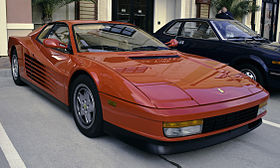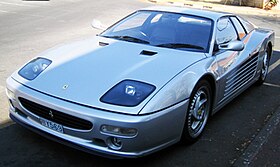Ferrari Testarossa
| Ferrari Testarossa, 512 TR and F512 M | |
|---|---|
 |
|
| Overview | |
| Manufacturer | Ferrari |
| Production | 1984–1996 |
| Assembly | Maranello, Italy |
| Designer | Leonardo Fioravanti, Ian Cameron, Guido Campoli, Emmanuele Nicosia, Diego Ottina at Pininfarina |
| Body and chassis | |
| Class | Sports car (S) |
| Body style | 2-door berlinetta |
| Layout | Rear mid-engine, rear-wheel-drive |
| Powertrain | |
| Transmission | 5-speed manual |
| Chronology | |
| Predecessor | Ferrari BB 512i |
| Successor | Ferrari 550 Maranello |
| Testarossa | |
|---|---|
 |
|
| Overview | |
| Production | 1984–1991 (7,177 produced) |
| Powertrain | |
| Engine | 4.9 L F12 291 kW (390 hp) |
| Dimensions | |
| Wheelbase | 2,550 mm (100.4 in) |
| Length | 4,485 mm (176.6 in) |
| Width | 1,976 mm (77.8 in) |
| Height | 1,130 mm (44.5 in) |
| Curb weight | 1,708.2 kg (3,766 lb) |
| Chronology | |
| Predecessor | Ferrari BB 512i |
| Successor | 512TR |
| 512 TR | |
|---|---|
 |
|
| Overview | |
| Production | 1991–1994 (2,261 produced) |
| Powertrain | |
| Engine | 4.9 L F12 319 kW (428 hp) |
| Dimensions | |
| Wheelbase | 2,550 mm (100.4 in) |
| Length | 4,480 mm (176.4 in) |
| Width | 1,976 mm (77.8 in) |
| Height | 1,135 mm (44.7 in) |
| Curb weight | 1,656 kg (3,650 lb) |
| Chronology | |
| Predecessor | Testarossa |
| Successor | F512 M |
| F512 M | |
|---|---|
 |
|
| Overview | |
| Production | 1994–1996 (501 produced) |
| Powertrain | |
| Engine | 4.9 L flat-12 328.1 kW (440 hp) |
| Dimensions | |
| Wheelbase | 2,550 mm (100.4 in) |
| Length | 4,480 mm (176.4 in) |
| Width | 1,976 mm (77.8 in) |
| Height | 1,135 mm (44.7 in) |
| Curb weight | 1,455 kg (3,207.7 lb) |
| Chronology | |
| Predecessor | 512 TR |
| Successor | Ferrari 550 Maranello |
The Ferrari Testarossa (Type F110) is a 12-cylinder mid-engine sports car manufactured by Ferrari, which went into production in 1984 as the successor to the Ferrari Berlinetta Boxer. The Pininfarina-designed car was originally produced from 1984 to 1991, with two model revisions following the ending of Testarossa production and the introduction of the 512 TR and F512 M which were produced from 1992 to 1996. Almost 10,000 Testarossas, 512 TRs, and F512 Ms were produced, making it one of the most-produced Ferrari models, despite its high price and exotic design. In 1995, the F512 M retailed for $220,000 (£136,500).
The Testarossa is a two-door coupé that premiered at the 1984 Paris Auto Show. All versions of the Testarossa had the power fed through the wheels from a rear-mounted, five-speed manual transmission. The rear mid-engine, rear-wheel drive layout (engine between the axles but behind the cabin) keeps the centre of gravity in the middle of the car, which increases stability and improves the car's cornering ability, and thus results in a standing weight distribution of 40% front: 60% rear. The original Testarossa was re-engineered for 1992 and released as the 512 TR, at the Los Angeles Auto Show, effectively as a completely new car, and an improved weight distribution of 41% front: 59% rear. The F512 M was introduced at the 1994 Paris Auto Show. The car dropped the TR initials and added the M which in Italian stood for modificata, or translated to modified, and was the final version of the Testarossa, and continued its predecessor's weight distribution improvement of 42% front: 58% rear. The F512 M was Ferrari's last mid-engine 12-cylinder car, apart from the limited edition F50, Enzo and LaFerrari, featuring the company's last flat engine. The Testarossa was replaced in 1996 by the front-engined 550 Maranello coupé.
...
Wikipedia
